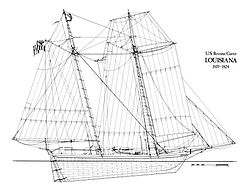|
USRC Louisiana
USRC Louisiana, was a wood hull topsail schooner designed by William Doughty that was commissioned in the United States Revenue Marine from 1819 to 1824. Assigned the homeport of New Orleans, Louisiana, she sailed the Caribbean extensively and was used mainly in anti-piracy activity.[3] ConstructionOn 6 April 1819, the Collector of Customs at New York City was authorized by the Treasury Department to build two cutters, one to be stationed in Louisiana and the other to be stationed at Mobile, Alabama.[6] The cutters were constructed by the Christian Bergh Shipyard at New York City using plans drawn up by naval constructor William Doughty. Doughty designed plans for 31-ton, 51-ton, and 80-ton cutters for the Revenue Marine. The Alabama-class cutters, consisting of Alabama and Louisiana were constructed on the 51-ton plan that measured 56 ft 10 in (17.32 m) on deck, with a 17 ft 4 in (5.28 m) beam, and a 6 ft (1.8 m) depth of hold. Both were rigged as fore-topsail schooners with a square stern, raking masts, and light rails instead of heavy bulwarks. Both cutters were not armed initially, but were designed to accept a pivot gun amidships of a 9-pound to 18-pound capacity.[7] ServiceAfter commissioning in New York City, Louisiana was assigned a homeport at New Orleans, Louisiana on 11 August 1819.[6] Capture of pirate schooner BravoWhile on her voyage to her homeport at New Orleans, on 31 August 1819, Louisiana assisted her sister ship, Alabama in the capture of the pirate vessel Bravo near Dry Tortugas.[8] Bravo initiated the attack on Louisiana with a volley of musketry, during which the first officer and three crewmen were wounded. The pirate ship was owned by Jean Lafitte and commanded by Jean Defarges, one of his lieutenants.[Note 3] Bravo had captured the Spanish schooner Filomena with a cargo of flour bound for Havana, Cuba out of Pensacola, Florida. The crew of Bravo were taken to New Orleans to await trial on charges of piracy while the passengers of Filomena were freed and returned to their ship.[3][6][9] Breton IslandOn 19 April 1820, Louisiana and Alabama raided the pirate operating base and stronghold on Breton Island. Both revenue cutters landed crewmen who burned buildings and woods. From Breton Island, both cutters continued westward searching for more pirate bases as part of a plan to eliminate piracy in the Gulf of Mexico.[4][6][10] In July 1820, Louisiana captured four pirate craft with about US$4,000 worth of stolen dry goods and a number of black prisoners at a position about 250 mi (400 km) west of Breton Island.[4] The presence of black prisoners suggested that the pirates were engaged in slave trade.[11] Later activityOn 18 September 1822, Louisiana assisted the sloop USS Peacock and the British schooner HMS Speedwell with the capture of a pirate schooner in Cuban waters which was reclaimed for a payment of US$1,000 in Havana by the vessel's lawful owners. Eighteen of the captured pirate crew members were sent to New Orleans for trial. Four more pirate vessels were captured by the trio of pirate hunters near Bahia Honda Key later in September, with two being burnt, and the other sent with prize crews to New Orleans. Eighteen of the captured pirate crew members were sent to New Orleans for trial.[4][12] In October 1822, Louisiana assisted in the capture of five pirate vessels of 80 to 100 tons each. Two were burnt, the others were sent to New Orleans with prize crews. Only one crew consisting of 17 men were taken to Camp Galvas near Pensacola, Florida; the rest of the vessel's crews managed to escape into the woods.[4][12] On 24 March 1824, the Collector of Customs at New Orleans ordered Louisiana sold.[12] She was sold for US$1,040.[4][Note 4] NotesFootnotes
CitationsReferences used
|
||||||||||||||||||||||||||||||||||||||
